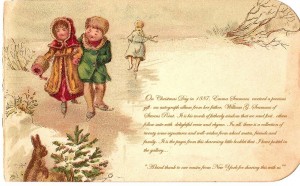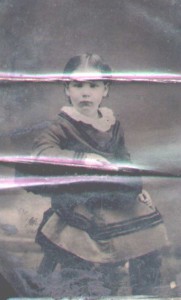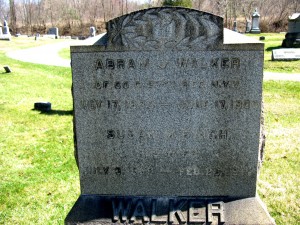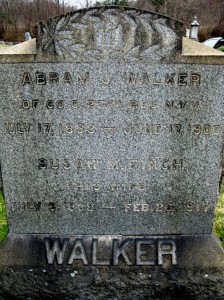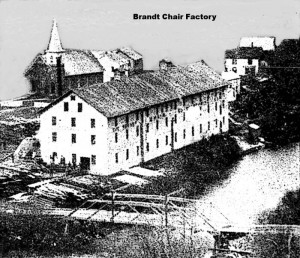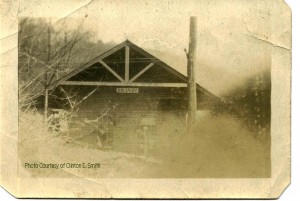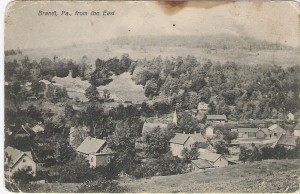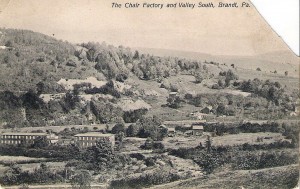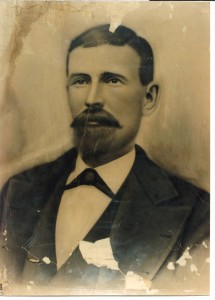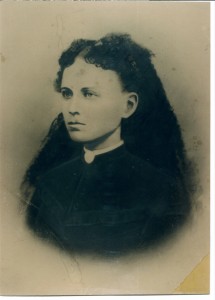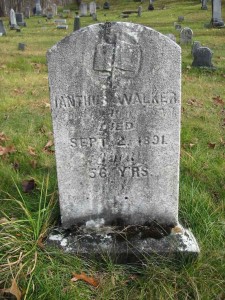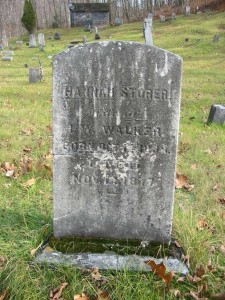Scanned signatures from Emma’s autograph book can be found in the Emma Seamans gallery.
Category Archives: Brandt
Abram Walker
Because Ianthus Walker doesn’t mention anything about his parents or siblings in all of his Civil War Pension Papers, I was intrigued when an Abram Walker gave a deposition on Ianthus’s behalf in an affidavit dated 1891. In the Commemorative Biographical Record by J. H. Beers, an extensive account of Abram Walker and his life is given – that he had lived in Brandt before his enlistments in the Civil War and then in Lanesboro after the war had ended. So, I didn’t know if it was mere coincidence that he and Ianthus shared the same last name or if they were indeed brothers or cousins. It has been something that I have been trying to find out now for the last few years….
Abram Walker was born in Sanford, NY in July of 1833, to William and Debbie (Monroe) Walker. CBR goes on to state that Abram was one of a family of thirteen children, (five of whom died in infancy) and it does list the remaining seven brothers and sisters but– Ianthus is not one of them. Because Abram’s father died when he was just a small boy, he was placed with a family in Deposit, NY (Delaware County). It was there that he learned to be a mason, and later, in 1856, he married Susan Finch. After the marriage, they settled in Brandt until 1861 when the Civil War broke out. Like Ianthus, Abram mustered into the army but served a longer term with two different companies.
In Abram Walker’s Civil War Pension Papers, there isn’t any reference to relatives at all. No children are mentioned in the papers – just one brief account by his wife on a Widow’s Pension Application that states “there aren’t any children under the age of 16 living in the household”. But in Beers’ Commemorative Record, it states that Abram and Susan had five children; three daughters and two sons but both sons drowned.
It seems probable that Abram and Ianthus Walker were related- they were both born in Sanford, NY just a few years apart. Ianthus lived in a household with a Thomas and Debbie Henderson. Both were married in January of 1856 – by the same minister. Familiar signatures appear on affidavits for Abram, giving the same testimonies as for Ianthus. Being that Brandt and Lanesboro were such little towns with only a few miles apart, it seems likely that they certainly knew each other and were possibly well acquainted.
Four years of soldiering took its toll on Abram Walker and his family – after his return from the Civil War, he was plagued with ill health and unable to keep steady work. Through his pension papers that I have posted in the gallery, you can read and appreciate this life story of another small family from Harmony Township…
I have posted numerous pages of Abram’s pension papers in the Abram Walker gallery.
The Town of Brandt, PA – Prosperous Times
“Brandt in a Nutshell”
A Happy New Year!
Charles Kessler, of State College, Pa., has returned to his home in the place for a couple of weeks.
S. C. Brandt, of Clinton, N. Y., paid a flying visit to his many friends here Friday.
Ed. Terrell of Oneonta, N. Y., spent a few days of the present week with his mother.
Engineer John Madden, of Binghamton, visited his parents of this place Sunday.
C. E. Folmsbee, of the firm of Folmsbee & Ives, cigar manufacturers of Binghamton spent Monday, on a hunting trip.
Conductor E. H. Madden and wife of Susquehanna, spent Christmas with his parents.
George Rivenburg, an employee in Soops’ stone quarry, met with a bad accident Saturday afternoon. While taking off top dirt an axe in the hands of a fellow workman flew off the handle, striking Rivenburg a glancing blow in the face, making an ugly wound.
Mrs. Monroe and family, of Philadelphia, are visiting her sister, Mrs. J. S. Perkins.
Did you see the Christmas tree at the Point?
The Transcript, Dec. 31, 1887
The Town of Brandt, PA – Brandt Faces an Uncertain Future
Both the American Chair Company and the Brandt Clay Product Company, both of Brandt, have shut down indefinitely.
Montrose Independent Republican 9-25-1896
The several industries at Brandt are in operation on full time. Prosperity has struck the Jefferson Branch.
Montrose Independent Republican 13 Aug. 1897
The Brandt Clay Product Company’s works have resumed operations after a shut-down of several weeks.
Montrose Independent Republican 8-25-1899
The citizens of Hallstead and the Brandt Chair Manufacturing Company have at last reached an agreement by which the Company will move its factory to Hallstead. It is expected that the new building will be ready for occupancy about July 1st.
Montrose Independent Republican 3-30-1900
The contract between the Brandt Chair Co. and the Hallstead Board of Trade has been signed. It will require about $10,000.00 to erect the buildings, which will be ready for occupancy by July 15. About 65 men will be employed at first.
Montrose Independent Republican 4-13-1900
J. S. Brandt is soon to discontinue the mercantile business at Brandt.
Montrose Democrat 2-14-1901
Several citizens of Brandt will apply for a charter for an intended corporation, it to be known as the Brandt Clay Product Co.
Montrose Independent Republican 11-7-1902
The new works of the Brandt Clay Product Co., are progressing rapidly. They expect to be ready to make brick by April 1st.
Montrose Independent Republican 1-16-1903
Dr. J. S. Brandt, will remove from Brandt to Susquehanna, 4-1
Montrose Independent Republican 3-20-1903
The Brandt Clay Product Co. has gone into bankruptcy.
Montrose Independent Republican 10-30-1903
The Brandt Clay Product Co. has commenced the shipment of large orders of brick. Both yards, under the management of Charles Lee, of Binghamton and C. C. Pratt of New Milford, with a large force of men and teams, under the supervision of M. W. Madden, of Brandt, are doing a hustling business.
Montrose Independent Republican 12-11-1903
At Trustee’s sale, the plant of the Brandt Clay Product Co. was sold to Andrew Blank, Jr. of Brandt, in consideration of about $35,000.00. The works will soon start up again.
Montrose Independent Republican 3-18-1904
It is reported that the Brandt acid factory will be closed for all time in less than a year, owing to the exhaustion of the wood supply.
Montrose Independent Republican 9-2-1904
The Town of Brandt, PA – Brandt Falls on Hard Times
Fire at Brandt
Sept. 27 – Fire which did damage in the village of Brandt, started as fires in the forests surrounding the village, and those in turn were threatening this evening to destroy the town. The fire started in the Brandt Chemical company’s plant. It was started by an explosion of acids being mixed by an employee of the company. A bucket brigade was soon formed and the villagers did their best to subdue the flames. In spite of their efforts the entire plant of the chemical company, the large warehouse of the company, a nearby blacksmith shop and the residence of Samuel Paugh were consumed. The sheds of the Presbyterian church were on fire, but the villagers succeeded in extinguishing them so as to save the church. Flying sparks set fire to the nearby woods, and the flames spread rapidly there, so as to surround the town and threaten it with destruction. Several other explosions occurred as the flames of the chemical plant reached the stored acids, with the first explosion, Foreman William Watkins, was blown through a window and thrown for some distance.
Montrose Democrat 24 Sept. 1908
The Town of Brandt, PA – Brandt’s Station on the Jefferson Division
A small passenger train slowly wends its way down the Jefferson Branch of the Erie Railroad, the engineer making a leisurely descent as he prepares to stop at Brandt Station. A few men are waiting with a load of quarry stone that has to be loaded; several milk cans are being kept cold on the back of an old wagon. The conductor quickly switches mail bags with the postmaster and two older ladies board the train. A man alights onto the wooden platform, he has the look and feel of “city” and in fact, he is “city”- an editor from Carbondale and he has come to do a piece about Brandt for his newspaper. As he walks down to stand on the wooden bridge that spans the Starrucca Creek, let’s join him there as he gathers his thoughts on how best to compose his story. And because it is his story, we need to let him tell it..
“Brandt’s Station on the Jefferson division is one of the places in this hilly country which is not calculated to make a favorable impression upon visitors who take their first view of the place from the depot platform. Directly opposite the station a rather dingy three-story structure looms up with bears upon its weather boards in huge letters, the legend “Brandt Chair Manufacturing Company”. A little to the left a group of smaller buildings may be seen, al bearing upon a smaller scale a similar legend. A few rods above the depot a wooden bridge spans the Starrucca Creek and a dilapidated looking blacksmith shop close by, completes the rather interesting first glimpse of Brandt’s.
The man who makes up his opinion of the village and the people who inhabit the place, from the first glimpse, will be forced to the conclusion later on that the old maxim, “first impressions are safest”, will not apply to Brandt’s. At least that was the conclusion which a party of Carbondale gentlemen arrived at after spending a few hours in the village on Saturday. The residence portion of the village completely hidden by the factory and the store buildings, and is not until on has crossed the stream and ascended the further bank that a view of the homes can be obtained.
The man who visits Brandt’s for the first time is treated to a grand surprise. Instead of a factory village, with its one story tenements that one naturally expects to see, he finds beautiful homes in the most charming homelike place in the world. The residence portion of Brandt’s is simply a beautiful park. The roadways are drives and the walks are free from the objections found by pedestrians in more pretentious places. Many of the dwellings are handsome modern structures and the entire park is filled with attractive homes. Near the entrance stands the church, a brick structure, handsomely finished and furnished, with a seating capacity for two hundred.
A little farther down the principal driveway stands the town hall which does service at all public gatherings. The building is new, of pretty design, and erected at a cost of nearly two thousand dollars. It contains a reading room, dining room and kitchen and on the second floor a commodious hall. This building is leased to the Young Men’s club at a nominal rental and every effort has been made to provide such elegant quarters for their use. Brandt’s industries are numerous and apparently profitable. The manufacture of chairs employs at present seventy-five men and boys. The chairs made at this establishment are among the finest made in this country. People who look with distrust upon factory made furniture, should visit these shops and see for themselves how substantially Brandt’s chairs are put together. The upholstering department is presided over by a gentleman who is master of the profession, and in the wood-making room several skilled carvers are employed who deftly transform the “oak wood” into life-like figures. Less than half a mile from the chair factory, down the stream, is located the brick yards where 25, 000 brick are made daily during the brick-making season. About the same distance up the stream from the village is located the tile and brick works which is the newest industry of the village. Here bricks are made that vie with the best grades f the Philadelphia article for smoothness. Paving brick which has withstood the severest of tests, and all manner of sewer pipe are also made at these works.
The clay deposits on the Brandt lands are the richest to be found anywhere. The mountains are filled with it and the pits at the tile works show that the clay bed is more than thirty feet thick. The supply is virtually inexhaustible and the men at the head of the brick-making enterprise have material for one of the largest plants in the world. The clay is free from sand and is fine enough when taken from the pits for use in the manufacture of all kinds of pottery. The Messrs. Brandt and Kessler, who own these industries, are pushing, enterprising gentlemen, and these industries, now in their infancy, will, we predict, within a few years attract the attention of the world by the superior quality of the ware made at Brandt’ tile and pottery works.”
The Tri-Weekly 9 Oct. 1890
Newspaper Items (Stevens Point Cemetery Burials) From Research at the Historical Society in Montrose, PA
George Kuhn, aged 55 years, died suddenly at his home on the outskirts of Susquehanna on Tuesday 7-20-1920. He is survived by one son, who resides in Stevens’ Point.
Montrose Independent Republican 8-6-1920
Roland Kuhn, of Stevens Point, aged 18 years, son of George Kuhn of Oakland, lost his life Sunday morning, near the Erie stone bridge at Lanesboro, by being hit by an Erie express train.
Montrose Democrat 11-20-1913
Elwin Kuhn, aged 22, was fatally injured while gunning, near his home at Stevens Point, on Saturday afternoon. In some manner his gun was accidentally discharged and an artery in one of his legs was severed. He died in a few hours. The funeral took place on Tuesday from the Steven’s Point Methodist Church.
Montrose Independent Republican 11-10-1899
At the home of his grandparents, Mr. and Mrs. W. G. Seamans at Steven’s Point, Feb. 22, 1898, occurred the death of George Wilson after an illness of about two months. Son of Frederick Wilson, he was age 13 years 5 months.
Montrose Democrat March 17, 1898
The death of Cora, the daughter of F. L. and Mary E. Wilson, age 17 years 10 months and 27 days formerly of Susquehanna, occurred in Scranton on Wed. May 3, 1899, after a protracted illness resulting from appendicitis. She is survived by a father, mother and two sisters, Mrs. Lillie McHenry of New Milford and Mrs. Nellie Bell of Windsor.
The remains were brought to Stevens Point and interred beside those of her brother; Rev. D. C. Barnes of Lanesboro conducted the services at the grave.
Montrose Democrat May 11, 1899
The remains of Elmer Carnegie, who died in Elmira, were brought to his home at Stevens Point, Wednesday, 10-15.
Montrose Independent Republican 10-24-1902
At his home in Stevens’ Point, PA, May 2, 1901, S. H. Carnegie , aged 74 years. Funeral held last Sunday from the Methodist Church in that place, Rev. D. L. Meeker officiating.
Montrose Independent Republican May 10, 1901
Albert A. Rockwell, 62 years old, died at his home in Stevens Point, Sunday 5-18-1924. He is survived by his wife; four daughters, Mrs. Linn Schenck , Mrs. Ray Keesler, Mrs. Walter Glover, and Mrs. Walter Brady, 3 sons, Ray, Merlin and Harold, 2 sisters, Mrs. James Reed and Mrs. M. H. Connelly. Burial in the Stevens Point Cemetery.
Montrose Democrat 5-22-1924
At the Brandt Brick Works on Saturday morning, Eugene Campbell of Stevens Point, was killed by the caving in of an embankment. Deceased leaves a widow and four children. The funeral took place, Monday, with interment in the Stevens Point Cemetery.
Unidentified Newspaper July 3, 1903
The remains of Mrs. Frank Burchell of Syracuse, N. Y. were brought to Stevens Point for burial Tuesday of last week. H. I. and C. F. Burchell brothers in law, from this place were in attendance.
Forest City News 9-20-1925
Frank Burchell, of Stevens Point, an aged and respected citizen, died 8-21-1913 at the home of his daughter, Mrs. Michael Sheffelm, Lanesboro.
Montrose Democrat 9-4-1913
Mrs. Horace Burchell of Stevens Point, died suddenly on Thursday of pneumonia. The funeral was held at the M. E. church in that place.
Forest City News 1-22-1914
The death of Horace Burchell, a veteran of the Civil War, occurred at his home in Endwell, March 12th. The body was brought to the home of his son, Chauncey Burchell, of this place. The funeral was held Monday at Stevens Point. Burial was also made at that place.
Forest City News 3-19-1931
Charles Tewksbury met his death last Saturday afternoon while helping a neighbor, Perry Bushnell, unload hay. Mr. Tewksbury was standing under the hay forks, when they fell striking him in such a manner that it severed the jugular vein and he died in a few minutes. Mr. Tewksbury was about 70 years of age, had lived in this neighborhood for many years and was respected by all who knew him. He is survived by his wife, Mrs. Hattie Tewksbury, two daughters, Mrs. Agnes Keating of Avoca, and Mrs. Mabel Corby of Waverly, and six grand children, Marjorie, Edith, Ruth, Agnes and Marion Keating, and Mrs. Anna Prentice, who had always made her home with her grandparents, up to the time of her marriage. The funeral was held Tuesday afternoon at 2 o’clock and burial was made in the Stevens Point Cemetery. Rev. Lamb of Lanesboro officiated.
Binghamton Newspaper 9-12-1918
Ianthus and Hannah Storer Walker
Researching family history is a bit like unraveling a big ball of tangled yarn….if you have patience and perseverance, you might end up with enough yarn to make a nice sweater but if you give up too easily and cut away half the knots, you might only have enough for a pair of small mittens. The same goes with searching out family members from the past, sometimes it just take time, patience and perseverance. And with the right mixture of all three, you might be able to sort out some of your relatives! That was the way it seemed when a few years ago, I began to be interested in Ianthus and Hannah Walker, my great, great grandparents. I had seen beautiful portraits of both and I realized that I didn’t know too much about them-where they were born, where they had lived and what other children they might have had. I only knew that they were my grandfather’s– Ray Milton Rockwell– grandparents. Ray Rockwell’s mother, Mary (Walker) Rockwell was their daughter and Mary (Walker) Rockwell had a twin sister, Sarah (Walker) Carnegie.
It was only by chance that I happened upon Ianthus’s civil war card at a Veterans Administration and my interest was peaked when I learned that he was buried alongside his first wife, Hannah (Storer) Walker in the Brandt Cemetery in Brandt, PA. I was thrilled to see that the names and dates were still pretty legible. The quest was on!
Ianthus W. Walker was born on July 13, 1836 in the little town of Sanford, NY to unknown parents. He gives no information about parents or siblings in his Civil War Pension Papers, just his birthdate and where he was born. His name first shows up on an 1850 census as a 14 year old boy living with a Thomas and Debbie Henderson, in 1860 he is married to Hannah Storer and they have a small daughter, Harriet. He is elusive in the 1870 census – his name can not be found. In 1880, Ianthus is living in Tioga County, NY and is married to Abigail (Carnegie) with several children, I have found out later through Ianthus’s Civil War Pension Papers that some of the children are Hannah’s and some are Abigail’s.
Ianthus Walker once farmed a large piece of land in Stevens Point but sometime after his return from Civil War, he moved to Brandt and was employed by neighbors to do farming and light carpenter work, at one time he worked at the Brandt Chair Factory. He came home a wounded man, was only able to work some of the time and as he got older and was steadily worsened by his wounds; he was barely able to keep employment at all. It has only been through Ianthus’s Civil War Pension Papers that I have been able to piece together this life story…I have posted numerous pages from his pension papers along with his and Hannah’s portraits, their gravestones, so you, too, can see how the Civil War had affected this small family from Harmony Township.

